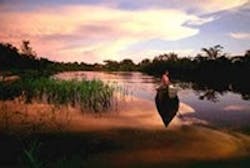UCSD Conducts Water-Borne Disease Studies
Researchers at the University of California, San Diego School of Medicine, along with colleagues at the University Peruana Cayetano Heredia in Lima, Peru, have developed a new approach for assessing the risk to humans of acquiring leptospirosis, a severe, water-borne disease that is the common cause of jaundice, renal failure and lung hemorrhage in urban areas throughout the developing world exposed to environmental water.
The approach uses advanced molecular methods to measure risk for infection and may also be applicable to other water-borne bacterial diseases.
“What we found supported our hypothesis that severe leptospirosis in the Peruvian Amazon is associated with higher concentrations of more virulent forms of the bacteria at sites of exposure and transmission,” said Joseph Vinetz, M.D., Associate Professor of Medicine in UCSD’s Division of Infectious Diseases.
Scientists will be able to determine if a sample of water contains Leptospira, as well as quantify how many of the bacteria are present. More densely contaminated water sources would be more likely to cause human disease than water with a lower concentration of Leptospira.
“This can have direct policy implications for health departments in monitoring the safety of water for bathing, cleaning and swimming – all ways that diseases are spread, not just by drinking contaminated water,” Vinetz said. He also said that the next step is to intervene and clean up the water sources, and assess the impact of cleanup on the incidence rate of human leptospirosis.
The researchers used a powerful molecular technology called polymerase chain reaction (PCR) to measure and compare levels of Leptospira in environmental surface waters at urban and rural sites in the Peruvian Amazon region of Iquitos. Leptospirosis, caused by bacteria of the genus Leptospira, is the most common disease in the world transmitted from animals to humans.
Annually, tens of millions of human cases of leptospirosis occur worldwide, and fatality rates can range as high as twenty to twenty-five percent in some regions. It occurs in both industrialized and developing countries, but is particularly prevalent in tropical countries where poor people live under highly crowded conditions, or in rural areas where people are exposed to water contaminated by the urine of Leptospira-infected mammals such as livestock or rats. Transmission also appears to coincide with warm weather and the occurrence of flooding, which washes soil contaminated with animal urine into water sources such as wells and streams.
Noted risk factors include the use of well or stream water, minding livestock, walking barefoot and the presence of rats and cats in the home.
Standard lab culture-based methods of identifying Leptospira in water and soil sources are time-consuming, laborious, and usually unable to identify pathogenic Leptospira at all. To overcome these limitations, the scientists analyzed relatively small quantities of surface water – for instance water from gutters, wells, puddles and streams – using quantitative real-time PCR assays that amplify small amounts of DNA. By measuring DNA, the researchers were able to effectively describe and quantify the amount of pathogenic bacteria present in the water samples.
The scientists then were able to connect the molecular identification of the bacterial pathogens in the water samples to those actually infecting people and causing acute leptospirosis in rural and urban areas. This approach allowed for a precise mechanistic connection between source of infection and human disease, allowing the researchers to measure the environmental risk for bacterial infection – an approach never used before.
“This method of risk assessment for infection may also be applicable to other water-borne diseases such as those caused by Shigella, Salmonella, Cryptosporidium, and E. coli,” said said Vinetz.
This work was supported by research and training grants from the Fogarty International Center and the National Institute of Allergy and Infectious Diseases of the United States National Institutes of Health.
Source: UCSD
